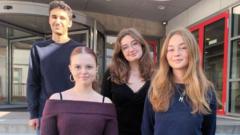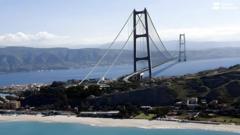Kalundborg, renowned for its production of the weight loss drug Wegovy, has seen substantial investment but grapples with local economic and educational challenges, influencing young people's decisions to leave.
Kalundborg: A Town Caught Between Corporate Growth and Community Challenges

Kalundborg: A Town Caught Between Corporate Growth and Community Challenges
Despite significant investments from Novo Nordisk, Kalundborg, Denmark, is struggling to retain residents, facing a future filled with mixed prospects.
Kalundborg, a quaint town of 16,000 nestled along the Danish coast, finds itself in a perplexing tandem of growth and stagnation. This small community has become synonymous with the weight loss drug Wegovy, produced by Novo Nordisk, a company that has poured over $8.5 billion (£6.5bn) into the town—an investment nearly equivalent to Monaco’s GDP. However, while the numbers suggest a bright future, the local reality tells a different story.
Mornings in Kalundborg are marked by a significant influx of factory workers commuting to the Novo Nordisk plant, leading to what locals refer to as the “Novo Queue.” Yet, this additional daily shuffle doesn’t translate into a rising population; most workers live in surrounding areas, commuting for their jobs rather than settling down in Kalundborg.
Significant investment leads to a staggering £400,000 per resident in Kalundborg, yet challenges persist. Local schools report low performance averages in core subjects such as Danish language and mathematics. Many facilities are aged and lack proper maintenance—playgrounds offer little more than outdated swings—creating an environment where educational expectations are low. Regional councillor Helle Laursen Petersen underlines the issue, noting that many parents feel their children are guaranteed jobs at Novo Nordisk, leaving them less motivated to pursue higher education.
Among local students, educational aspirations collide with a desire for broader horizons. While some express an eagerness to explore opportunities in larger cities, others, like Ali and Marie, hold onto hopes of returning post-education for employment and a more scenic lifestyle in their hometown.
Brian Sonder Anderson, the owner of the Blue Angel cinema and local traders association head, observes fluctuating success in local businesses. Restaurants and supermarkets thrive during worker lunch hours, while shops offering clothing and shoes often struggle to remain open. Many families in Kalundborg find themselves in precarious economic situations, squeezed by housing affordability challenges in nearby Copenhagen.
The town also faces a significant public health issue, with rates of childhood obesity placing it among the highest in Denmark. Novo Nordisk’s commitment to Kalundborg, which plans to create 1,250 new jobs to complement the existing 4,500 at the facility, coincides with the company emerging as Europe's most valuable corporation with a whopping revenue of over $33 billion last year.
Kalundborg's future feels uncertain. The mayor, Martin Damm, expresses optimism about job creation and its potential to foster long-term prosperity. Students like Miguel, an international student, foster hopes for a diverse, thriving community. Meanwhile, the construction of a new highway seeks to reduce the congestion caused by the influx of workers.
At the crossroads of opportunity and challenge, Kalundborg teeters on the edge of transformation. As young residents grapple with their future, many hope for a gradual shift towards a more vibrant, multicultural society that may compel them to return home after their studies.





















